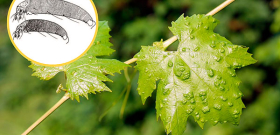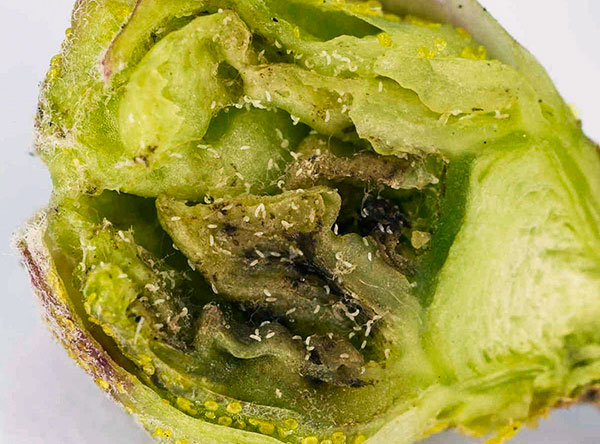
Currant bud mite (colloquially they also often say “currant”) is a dangerous highly specialized pest of plants of the gooseberry family. It feeds exclusively on the juices of the rudiments of leaves in the buds, and it mainly harms blackcurrants and gooseberries, affecting red and white currants to a much lesser extent and is not found on other trees and shrubs.
In terms of the danger that the kidney mite poses to currants, it is inferior only to spider mites. Moreover, it harms both directly and indirectly: hitting the kidneys in the fall, it leads to a violation in the development of leaves in the spring, slowing down the growth of shoots and reducing the yield of the bush, and transferring the blackcurrant reversion virus between plants, it infects healthy bushes, which over time completely cease to bear fruit and degenerate. Due to the incurability of reversion, the affected plantation must be completely renewed.
At the same time, like all microscopic mites, the currant mite reproduces very quickly and already in the second year after appearing on the plantation leads to a noticeable decrease in yield, and a year later it infects almost all plants located close to each other.These features of its biology dictate the need to apply very fast, literally emergency measures to combat it, and it is necessary to fight both in the spring, when the mass reproduction of pests begins, and in the fall, when the affected buds are most easily destroyed. It is important here to detect such affected kidneys as early as possible. Fortunately, this is not difficult to do, unlike the tick itself - it is almost impossible to see it without special devices ...
Appearance and habitat of the pest
The bud mite is a microscopic pest. Adults of this species reach a length of about 0.2 mm, a width of 0.03-0.05 mm. Larvae and nymphs are much smaller - from 0.1 to 0.13 mm in length. It can only be viewed through a microscope, or with a powerful magnifying glass with a 10x magnification. The photo below, taken through a microscope, shows what an adult looks like:
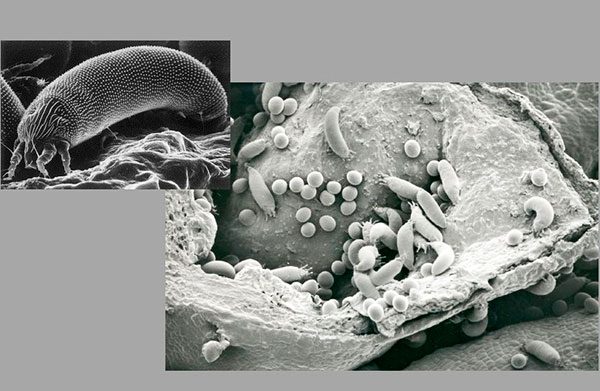
The true color of her body is white, the covers are slightly transparent. Larvae and nymphs have a vitreous tint.
Unlike most ticks known to man - ixodid, spider mites - the kidney has an elongated body and only two pairs of legs. The entire body of the pest is divided into ring-shaped segments, the number of which differs between the sexes - the female has 70, the male has from 28 to 62. Each segment has small spines, and even long thin hairs grow on individual rings. They are clearly visible in the photo under a microscope:
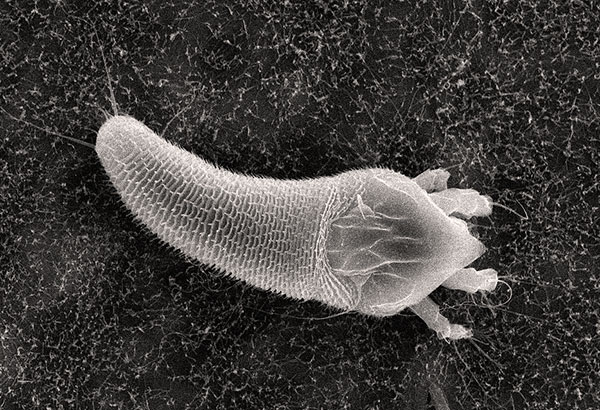
With the naked eye, the currant mite becomes noticeable only in large quantities. Mass accumulations of it appear in May-June, at which time they can be detected even without special means - mites form a continuous whitish coating on the bark of shoots, on buds, on buds and on flowers.But even here, it will not work to see every single individual without a microscope.
The currant bud mite is distributed throughout almost the entire European part of Russia, in the west of Kazakhstan, in Ukraine and throughout Western Europe. In addition to Europe, it is also found in small quantities in Australia and Asia. On the territory of the entire range, it affects almost exclusively shrubs of the gooseberry family.
On a note
In the USA and Canada, the bud mite is listed as a quarantine pest and all biological material on which it can settle is subject to strict checks. The methods used to protect against it are quite effective, due to which this species has not yet been discovered on the North American continent.
Throughout its range, the currant bud mite is rigidly attached to the distribution sites of currants or gooseberries. Even in those areas where the climate suits it, but species of the genus Ribes do not grow, this pest does not exist.
Life cycle of a bud mite
Like most relatives in the order of trombidiform ticks, the kidney tick is characterized by high fecundity and rapid reproduction.
Its full life cycle from egg to egg is 20-40 days, depending on the temperature at which the nymphs develop. At the same time, the tick has very pronounced differences in the way of life between different types of generations.
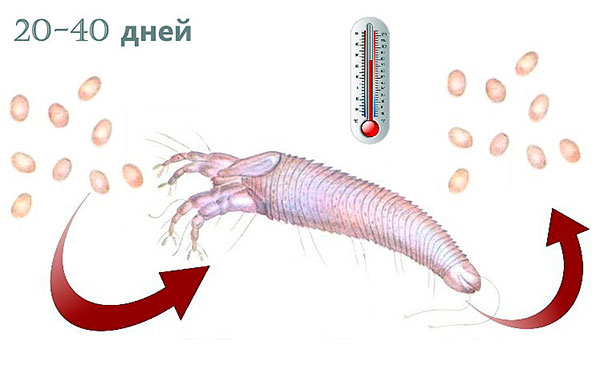
The life cycle of a kidney mite depends on the air temperature, and its duration is from 20 to 40 days.
So, spring-summer generations develop as quickly as possible in conditions of high temperatures and an abundance of food. During the warm season of the year at the latitude of Moscow, three generations can fully develop, in the south of Ukraine - up to 5-6 generations.It is the mites of these generations that actively spread and move between the bushes, infecting more and more new plants.
In autumn, when the air temperature drops and leaves fall, a generation of wintering females develops. They have increased resistance to low temperatures and, after reaching maturity, they are fertilized, but they do not lay eggs and go into hibernation in the wintering buds of the bush, under the cover of leaf buds. Males of this generation die.
In spring, when the average daily air temperature rises to +5°C and the currant buds begin to swell, the overwintered females wake up, begin to feed and lay eggs. Individuals of the first spring generation are hatched from them, which do not yet leave the kidneys and actively reproduce inside them. As a result, individuals of three generations accumulate in the kidneys - some of the overwintered females, ticks of the first spring generation, and nymphs of the second generation.
Considering that one female lives 3-6 weeks, most of them have time to see their "grandchildren". And despite the fact that the same average female lays about 80-90 eggs in her life and in the kidney they are all reliably protected from predators and environmental factors, already in the third generation the number of mites in the kidneys reaches critical levels of 3000-4000 individuals per year. each kidney, sometimes up to 8000.

One infected currant bud can contain up to 4,000 mites.
This period coincides with the flowering time of currants and gooseberries. At this time, some of the first generation and most of the second generation mites leave the buds and travel through the bush in order to penetrate new, not yet infected buds.It is during such migrations that they can be seen on the bushes with the naked eye. Such a mass "exodus" lasts almost 2 months, but its peak falls on the first 16-20 days. On this journey, almost all of them die from predators (they feed on predatory mites, ladybugs, larvae of moth flies, and many, many other animals) or are blown away from the bushes by the wind and die, failing then to climb onto a new plant bush. However, about 1% of dispersing individuals still reach uninfected buds (including after being transferred by wind or birds to other bushes) and settle in them. Here, 1-3 year old generations develop, which, by their nutrition, disrupt the processes of laying and forming the rudiments of leaves, due to which each infected bud acquires a characteristic swollen shape. Autumn females appear in these buds and remain to winter.
Approximately 75 days after the onset of bud swelling and egg laying in all last year's buds, ticks die - sap flow practically stops here, and the buds dry up. On an infected plant, pests remain only in newly formed buds, where representatives of the younger generations managed to move from last year's buds.
The development of each individual occurs according to a typical scheme for herbivorous mites: 3-7 days after its laying, a larva hatches from the egg, which begins to feed, after another 3-7 days it molts into a nymph, and then after 2-3 weeks it turns into an adult tick .
Fertilization in currant mites is spermatophoric. Males leave spermatophores in their places of movement - special capsules with sperm and a jelly-like shell.
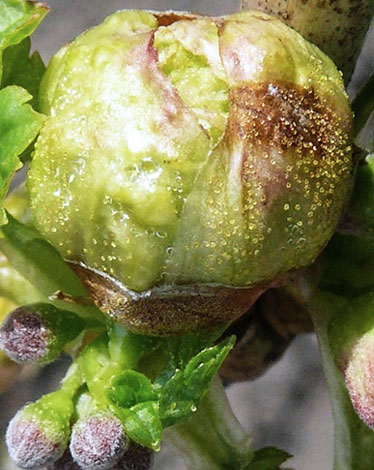
On the kidney, jelly-like capsules are visible, in which the sperm of male ticks is located.
Females, crawling past such capsules, capture them with their genitals, crush them and direct the contents into the spermatheca, after which the eggs are fertilized.
It is interesting
Females lay eggs irregularly, but absolutely regardless of whether they have been fertilized. If the insemination of eggs does not occur, then males hatch from them, and females hatch from fertilized eggs.
Only females overwinter at the kidney tick. Only they, and only representatives of the autumn generation, have developed resistance to low temperatures. Males, larvae, nymphs and eggs laid before wintering freeze out.
What does the pest eat and what crops does it infect?
Like most herbivorous mites, the currant bud mite feeds on plant sap, which sucks the buds of leaves in the buds from the veins. Since the period of active feeding of all individuals falls on the warm season, when the sap flow in the leaves is maximally intense and the kidneys are abundantly supplied with liquid with nutrients, even with a large population of ticks there is enough food.
Each individual, even a relatively small larva, is able to pierce the vein of the leaf rudiment and suck juice from it. This is enough for the second generation of mites to suck out almost all the nutrients when the kidney is infected, and the kidney could not open at all. This is exactly what happens with "tick" buds - in the spring they do not bloom and shoots do not grow from them.
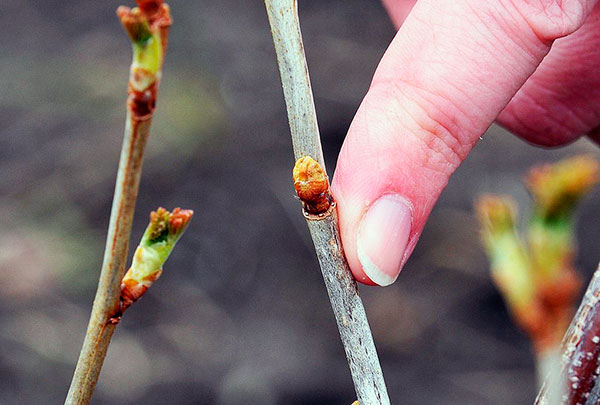
From a kidney infected with a tick, the leaf does not grow.
On a note
It is believed that when settling in a bush, mites can sometimes feed on young, already blossoming leaves.However, this happens relatively rarely and the mites do not cause significant harm.
The currant bud mite does not infect plants that do not belong to the gooseberry family. On an apple tree, cherry, sweet cherry and other trees and shrubs, it is replaced by a brown fruit mite - it is also small, its nymphs also infect the kidneys in bulk, but both nymphs and adults feed on leaves in large quantities. The same nymphs of the brown fruit mite can also be found on the bark of the shoots, where they move to molt.
On a note
There are no varieties of bud currant mites. This is one species that only affects currants and gooseberries. Often other garden pest mites are confused with it: leaf gall mites, plum gall mites, hazel felt mites, pear gall mites and some others. All these are completely different species, differing from each other both in biology and in food preferences. In particular, gall mites feed mainly on leaves, and either hibernate in buds or colonize them in small quantities. The currant mite is a specialized pest of the kidneys.
Of the gooseberries, the currant bud mite infects mainly black currants, to a lesser extent gooseberries, and even less often red and white currants (their "tick" buds die off before the active resettlement of ticks begins, and pests die in large numbers). Some hybrids, for example, yoshta, are practically not affected by ticks, for which they, in fact, were bred.
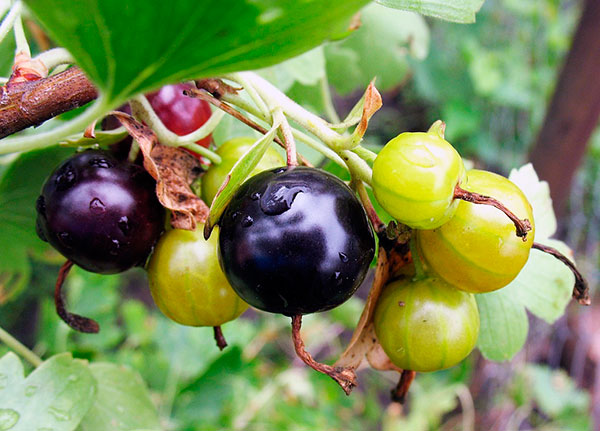
A hybrid of currant and gooseberry, Josta, is resistant to bud mites.
At the same time, there are few varieties of blackcurrant that are resistant to bud mites, and this resistance is not absolute.However, varieties are highly resistant:
- Vigorous;
- Early Potapenko;
- Kipian;
- Nara.
Currant Otradnaya is considered to be above average resistant to this pest.
Of the varieties of red currant, the Memory of Gubenko is considered the most resistant, the most resistant are Transdanubian, Early sweet, Seryozhka, Dutch early.
Kidney mites do not bite people, they do not parasitize on the body and do not pose a direct danger. At the same time, they are relatives of iron mites, due to their microscopic size, they live in the human sebaceous glands and feed on secreted sebum.
Association with viral diseases of currant
The danger of a bud mite lies not only in the fact that it disrupts the development of buds and entire shoots, but also in the fact that it carries a very dangerous disease - terry (reversion) of blackcurrant. This viral disease cannot be cured, and the bushes affected by it either cease to bear fruit altogether, or their yield is reduced by more than half. As a rule, diseased plants are subject to uprooting and destruction.
The tick carries the terry virus in its body and infects the plant, having fallen on it from another, diseased bush, when it begins to suck the juice. Consequently, infection with the disease occurs mainly in May-June, when ticks are most actively settled and can be transferred from one plant to another.
On a note
Terry blackcurrant is a polyphyletic disease, that is, caused by several different pathogens. That is why some sources call it mycoplasmosis, others call it a viral infection.In Russia and most of Ukraine, it is the virus of the genus Nepovirus that causes reversion.
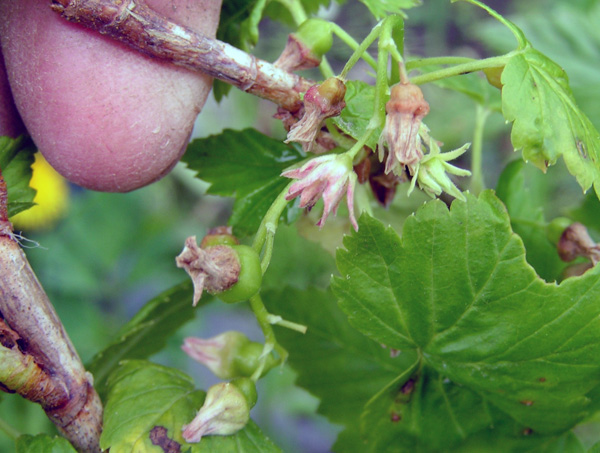
Bud mites are carriers of the blackcurrant terry virus. At the same time, the flower petals turn inside out and dry out.
After entering the juices of the plant, viral particles are carried along the shoots and penetrate into various cells. Here they replicate, new virions infect neighboring cells, and by the end of the season the plant is completely infected. Next year, its flowers will acquire unnatural thinned and twisted petals, they will either not set fruit, or the berries will be small and disfigured. Sometimes racemes degenerate into thin twigs with small scales instead of flowers. At the same time, the leaves become smaller, thinner, they acquire a brownish, dark green color and lose the smell characteristic of currants.
It is believed that the harm caused by blackcurrant terry is greater than the harm directly from the bud mite. But since it is the tick that is the main vector for the transfer of the pathogen of this disease, the fight against it is the most effective prevention of reversion.
Causes of currant infection with a kidney mite and predisposing factors
Most often, the spread of ticks occurs with planting material. Rooted cuttings, parts of shoots taken for grafting, young seedlings grown next to adult infected plants can be infected. It is with them that the tick enters areas where it was not previously.
Directly between the bushes, ticks are transferred in a variety of ways. Fortunately, their sizes contribute to this:
- Ticks can be carried by the wind;
- Quite often, individual individuals cling to insects (including pollinators) and are carried with them;
- The mites can get on and be carried by workers on site;
- Settling mites can be shaken from nearby branches by slopes and gusts of wind, or when an animal runs past them;
- Birds that perch on bushes or forage there may carry mites on their feet or on leaves and branches they carry as nesting material.

Birds can become carriers of kidney mites.
Of all these factors, the only (and most important) that a person can influence is precisely the drift with planting material. This must be remembered when taking measures to protect the site from infection.
Factors predisposing to infection of the site include too dense planting of currant bushes (where ticks can shake off and fall from one bush to another), the lack of inspections, control and application of agricultural methods that would reduce both the spread rate and the survival rate of ticks on the bushes.
Pest control methods
The main measures to combat the bud mite include the treatment of infected bushes with powerful acaricidal agents. Such preparations quickly and completely destroy all pests that have been sprayed with them. In addition to such treatment, measures are taken to destroy random surviving or newly introduced ticks in the fall, and agrotechnical measures are also taken.
It is necessary to treat infected currants with acaricides at the beginning of budding, when ticks begin to get out of autumn buds and move to those that are not yet infected, and again immediately after flowering, at the peak of pest settlement.
In the fall, before wintering the plant, and in the spring, before the buds swell, it is very important to inspect the bushes and remove all "tick" buds.Their main features are enlarged size, rounded shape (they look like small cabbages) and parts of deformed leaves sticking out from under the expanding scales. All of them need to be plucked, and if, apart from such buds, there are no healthy ones on the shoot, then cut off the entire shoot. This will prevent the reproduction and resettlement of ticks after the flowering of the bush.
With a strong infection of the bush, it needs to be rejuvenated - cut off the shoots as much as possible to form new ones with healthy, uninfected buds.
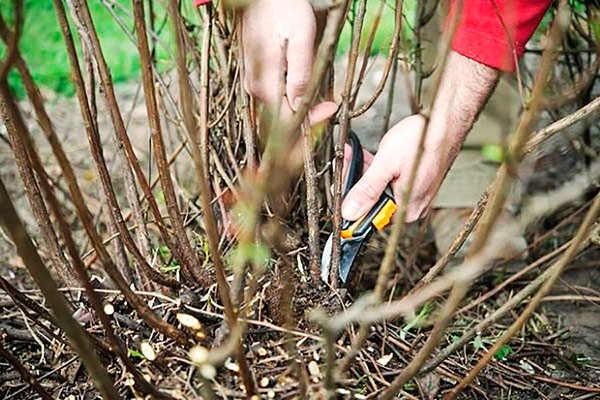
If the bush is significantly affected by the bud mite, then it should be rejuvenated by cutting off the shoots.
All infected buds and shoots are burned.
After the ticks have been removed from the bush, somehow it is not necessary to treat it additionally. With proper care, the plant will recover on its own.
If on some bushes, along with a bud mite, signs of infection with terry are found, it is advisable to uproot them and replace them with healthy ones. Save them and force them to bear fruit will not work.
To a certain extent, it will be useful to grow various garden and ornamental plants in the aisles and near currants, on which ladybugs settle in abundance. These beetles are natural enemies of ticks and actively eat them. The more of them there are on the site in general and on currants in particular, the less kidney mites there will be.
Remedies for kidney mites
Currant mites can be controlled using a large number of highly effective acaricides. These include:
- Organophosphorus insectoacaricides - karbofos (Malathion, Karbofos, Fufanon, Alatar, Antiklesh), chlorpyrifos (Shaman, Dursban, Parus), pyrimiphos-methyl (Aktellik, Kamikaze);
- Preparations based on lipid synthesis inhibitors (Envidor, Oberon, Movento, Kontos);
- Chitin synthesis inhibitors (Nissoran);
- Pyrethroids (Inta-vir, Taran, Spark, Proteus);
- Avermectin acaricides (Aktofit, Fitoverm, Vertimek);
- Sulfur preparations (only for currants, since they cause severe burns in gooseberries).

Biopesticides that have shown high efficiency in the fight against bud mites.
Before harvesting, the plant should be sprayed with safer means for people - Envidor, Oberon, Nisoran, and after harvesting the berries, you can use the more affordable and fast-acting Malathion, Actellik, Inta-vir and others. In addition, each subsequent treatment should be carried out with a preparation different from the previous one in order to ensure maximum effectiveness of baiting against ticks.
In August-early September, it is possible to carry out light prophylactic treatment with drugs with a pronounced systemic effect - Fitoverm, Vertimek. The active substance of the drug will penetrate into the juices of plants and poison mites, which are reliably protected from direct spraying with bud scales.
Sometimes they try to fight with a kidney mite with the help of folk remedies. It is believed that it can be destroyed by decoction of onion peel, boiling water, decoction of tobacco, infusion of wormwood, dandelion or walnut leaves. Such products do kill ticks, but they do it more slowly and not as effectively as specialized insecticides. As a result, in order to completely get rid of pests, bushes need to be treated with such folk remedies or even washed thoroughly more than twice, and the remedies themselves should be prepared for a long time before that.All this complicates the fight, but also makes it safer for the human handler and for those who will then eat the berries.
Prevention of the appearance of a kidney mite on currants
The basis for the prevention of infection of a plantation with a bud mite is a thorough inspection, quarantine and rejection of planting material. All purchased seedlings must be carefully examined, literally every kidney should be studied, checked that it does not look like a tick-infected one. If detected, such kidneys are removed.
Similarly, a thorough inspection of the bushes is carried out in late autumn, after the leaves fall, and in early spring, before the buds swell. Both infected buds and completely affected shoots are removed and destroyed.
Proper care of the bushes and agrotechnical methods of prevention are very important. All plantings of blackcurrant and gooseberries should be light, not thickened, the bushes in them should not touch each other or contact in strong winds. When the bushes grow, their crown is formed in such a way that the shoots are stretched in height, but do not fall apart to the sides and do not lean towards neighboring bushes. In this case, even the infection of one bush will be easier to localize without transferring ticks to neighboring plants.
It is important to regularly carefully feed all bushes with mineral fertilizers and manure. This contributes to the formation of a large number of shoots and increase the stability of the bush even when infected. In any case, the stronger and healthier the bush, the less it will be affected by infestation with mites and the fight against them.
How to deal with kidney mites? Expert advice

